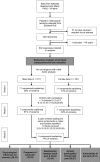The development and exploratory analysis of the Back Pain Attitudes Questionnaire (Back-PAQ)
- PMID: 24860003
- PMCID: PMC4039861
- DOI: 10.1136/bmjopen-2014-005251
The development and exploratory analysis of the Back Pain Attitudes Questionnaire (Back-PAQ)
Abstract
Objectives: To develop an instrument to assess attitudes and underlying beliefs about back pain, and subsequently investigate its internal consistency and underlying structures.
Design: The instrument was developed by a multidisciplinary team of clinicians and researchers based on analysis of qualitative interviews with people experiencing acute and chronic back pain. Exploratory analysis was conducted using data from a population-based cross-sectional survey.
Setting: Qualitative interviews with community-based participants and subsequent postal survey.
Participants: Instrument development informed by interviews with 12 participants with acute back pain and 11 participants with chronic back pain. Data for exploratory analysis collected from New Zealand residents and citizens aged 18 years and above. 1000 participants were randomly selected from the New Zealand Electoral Roll. 602 valid responses were received.
Measures: The 34-item Back Pain Attitudes Questionnaire (Back-PAQ) was developed. Internal consistency was evaluated by the Cronbach α coefficient. Exploratory analysis investigated the structure of the data using Principal Component Analysis.
Results: The 34-item long form of the scale had acceptable internal consistency (α=0.70; 95% CI 0.66 to 0.73). Exploratory analysis identified five two-item principal components which accounted for 74% of the variance in the reduced data set: 'vulnerability of the back'; 'relationship between back pain and injury'; 'activity participation while experiencing back pain'; 'prognosis of back pain' and 'psychological influences on recovery'. Internal consistency was acceptable for the reduced 10-item scale (α=0.61; 95% CI 0.56 to 0.66) and the identified components (α between 0.50 and 0.78).
Conclusions: The 34-item long form of the scale may be appropriate for use in future cross-sectional studies. The 10-item short form may be appropriate for use as a screening tool, or an outcome assessment instrument. Further testing of the 10-item Back-PAQ's construct validity, reliability, responsiveness to change and predictive ability needs to be conducted.
Keywords: Epidemiology; Pain Management; Primary Care.
Published by the BMJ Publishing Group Limited. For permission to use (where not already granted under a licence) please go to http://group.bmj.com/group/rights-licensing/permissions.
Figures
Similar articles
-
Cross-sectional survey of attitudes and beliefs about back pain in New Zealand.BMJ Open. 2014 May 23;4(5):e004725. doi: 10.1136/bmjopen-2013-004725. BMJ Open. 2014. PMID: 24859999 Free PMC article.
-
Measurement of acute nonspecific low back pain perception in primary care physical therapy: reliability and validity of the brief illness perception questionnaire.BMC Musculoskelet Disord. 2013 Feb 1;14:53. doi: 10.1186/1471-2474-14-53. BMC Musculoskelet Disord. 2013. PMID: 23369321 Free PMC article.
-
Investigation of four self-report instruments (FABT, TSK-HC, Back-PAQ, HC-PAIRS) to measure healthcare practitioners' attitudes and beliefs toward low back pain: Reliability, convergent validity and survey of New Zealand osteopaths and manipulative physiotherapists.Musculoskelet Sci Pract. 2017 Dec;32:44-50. doi: 10.1016/j.msksp.2017.08.008. Epub 2017 Aug 23. Musculoskelet Sci Pract. 2017. PMID: 28858681
-
A scoping review to explore the use of the Health Care Providers' Pain and Impairment Relationship Scale.PM R. 2024 Nov;16(11):1248-1263. doi: 10.1002/pmrj.13186. Epub 2024 Jul 3. PM R. 2024. PMID: 38958442
-
Condition-specific outcome measures for low back pain. Part II: scale construction.Eur Spine J. 2004 Jul;13(4):314-24. doi: 10.1007/s00586-003-0666-0. Epub 2004 Mar 17. Eur Spine J. 2004. PMID: 15029489 Free PMC article. Review.
Cited by
-
Changes in physiotherapy students' beliefs and attitudes about low back pain through pre-registration training.Arch Physiother. 2021 May 17;11(1):13. doi: 10.1186/s40945-021-00106-1. Arch Physiother. 2021. PMID: 33993879 Free PMC article.
-
Development and measurement properties of the AxEL (attitude toward education and advice for low-back-pain) questionnaire.Health Qual Life Outcomes. 2022 Jan 10;20(1):4. doi: 10.1186/s12955-021-01908-4. Health Qual Life Outcomes. 2022. PMID: 35012565 Free PMC article.
-
Cross-sectional survey of attitudes and beliefs about back pain in New Zealand.BMJ Open. 2014 May 23;4(5):e004725. doi: 10.1136/bmjopen-2013-004725. BMJ Open. 2014. PMID: 24859999 Free PMC article.
-
Management of Low Back Pain: Do Physiotherapists Know the Evidence-Based Guidelines?Int J Environ Res Public Health. 2023 Apr 23;20(9):5611. doi: 10.3390/ijerph20095611. Int J Environ Res Public Health. 2023. PMID: 37174131 Free PMC article.
-
The Flares of Low back pain with Activity Research Study (FLAReS): study protocol for a case-crossover study nested within a cohort study.BMC Musculoskelet Disord. 2022 Apr 21;23(1):376. doi: 10.1186/s12891-022-05281-1. BMC Musculoskelet Disord. 2022. PMID: 35449043 Free PMC article.
References
-
- Hoy D, Bain C, Williams G, et al. A systematic review of the global prevalence of low back pain. Arthritis Rheum 2012;64:2028–37 - PubMed
-
- Accident Compensation Corporation. Injury statistics tool. Secondary injury statistics tool, 31 August 2013. http://www.acc.co.nz/about-acc/statistics/injury-statistics/index.htm
-
- Maniadakis N, Gray A. The economic burden of back pain in the UK. Pain 2000;84:95–103 - PubMed
-
- Dagenais S, Caro J, Haldeman S. A systematic review of low back pain cost of illness studies in the United States and internationally. Spine J 2008;8:8–20 - PubMed
-
- van Tulder MW, Koes BW, Bouter LM. A cost-of-illness study of back pain in The Netherlands. Pain 1995;62:233–40 - PubMed
Publication types
MeSH terms
LinkOut - more resources
Full Text Sources
Other Literature Sources
Medical


